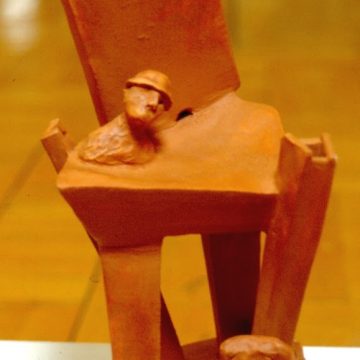As I approach the end of another year, I consider the issues and solutions that have been the focus of my work as an artist who is also a gallery curator and an educator. In those roles, my greatest pleasures are either:
– to invite seasoned artists working in a variety of mediums or styles to join me in gallery to create works to a theme or concept which are then exhibited, or
– to bring artists together who would normally rarely interact and have them share in an exhibition experience that also introduces them and their work to a new, general public.
As an example of the creation projects I have done, in October/November 2017, for the exhibition Lattices and Interstices at Galerie de la Ville in DDO, Quebec, I invited 73 artists to joined me. Each artist was given 24”x24”x1.5” wood panels and I challenged them to create works using them in their chosen medium/s. Artists were to express their own personal aesthetic. Our 117 panels were then displayed in a ‘lattice’ pattern to represent the support structure that artists of all societies create on which cultures can grow and thrive. During the exhibition phase of the project, the public saw the huge variety and scope of creativity, imagination, approach and technique despite the ‘sameness’ imposed by the fixed size of the panels.
Conversely, in April 2017, for the Art at Home exhibition I held for a month in an otherwise empty store I rented at Fairview, a popular mall in Pointe Claire, Quebec, I invited 16 artists to exhibit eight works each and created a non-commercial exhibition environment. The mall audience was invited in to look closely and at their leisure at the work; they could meet the artists, discuss the imagery and ask questions about the processes without fear of judgement or pressure to buy. Many returned again and again with their family and friends. Over 7,000 people who would never have thought to walk into a gallery enjoyed taking mental time out of being hurried consumers of disposables. Some even chose to buy or commission works from the artists directly.
So much of art today is misrepresented that these are ways I have found to return the attention to the fact that an art work isn’t just a product, it is the result of an artist’s process. There would never be the former without the latter, and where there is ‘expression’, there is always experience and intent motivating it, even if these are hidden or coded. It takes actual, real-time engagement and attention to see it.
It is a loss that our modern eye is conditioned by mechanical image capture methods. For many of us, it is rare that the experience of seeing images began with actual paintings or sculptures; if we pre-date 2000 we likely saw a photograph first, if not, we looked first at digital images. These methods eliminate the very sensation of process.
When mediated by technology, the seeing in art is reduced in time and space to a glance or a look and we are fooled into thinking we have absorbed the full experience of the work. The result is that when people subsequently look at a work of art in a gallery, they’ve learned to see a ‘picture’, not really a painting or a sculpture or a print or watercolour, or whatever the process the artist underwent to create it. To their eye, the differences between these creation methods are lost. To me, the tragedy is that they are not even aware of what they have missed.
I hope by these types of exhibits to keep artists sharing experiences and to keep audiences attuned to the creation processes.










